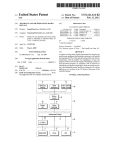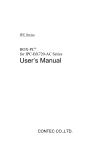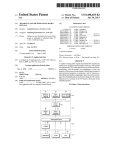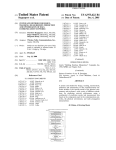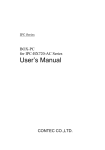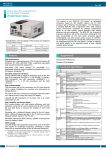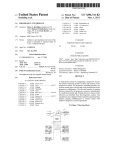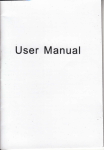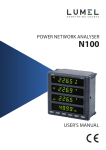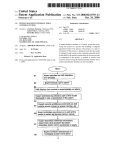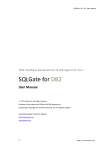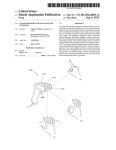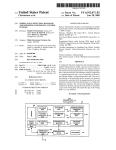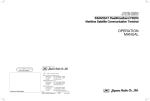Download hAonitor Measurement Reports 7 Adngsrtrtqhgniftrggggency
Transcript
US 20120108271A1 (19) United States (12) Patent Application Publication (10) Pub. No.: US 2012/0108271 A1 LEE (54) (43) Pub. Date: APPARATUS AND METHOD USING RADIO SIGNALS (75) Inventor: (73) Publication Classi?cation (51) Jung-HWan LEE, Staines (GB) Assigneez May 3, 2012 Int. Cl. H04W2 4/00 samsung Electronics Co” Ltd” (52) (200901) US. Cl. ................................................... .. 455/456.6 SuWon-si (KR) (21) Appl. No.: (22) (63) 13/349,135 (57) Jan- 121 2012 A method of using radio signals transmitted for reception by mobile user equipment that includes receiving, With mobile _ _ Related U's' Apphcatlon Data user equipment (UE), radio signals having at least one format; monitoring, With the mobile user equipment, at least one _ Flledi Continuation of application NO 12/397,701, ?led on Man 4 2009 HOW Pat NO 8 121 614_ s (30) s s ABSTRACT property of the received radio signals; identifying a pattern in said monitored property or properties; and in response to 3 identifying said pattern, triggering at least one action accord Foreign Application Priority Data ing to the identi?ed pattern, and/or providing the UE With an indication of a location of the UE based at least part of the Mar. 4, 2008 (GB) ................................. .. 08040131 Service Request identi?ed pattern. ~1Q0 i Scan Pattern D8 ~105 no Is the Pattern DB has relevant history data? Ego NO ' I I ACllV?iB Trarnlng Mode & Reiect the request Training Mode End Yes Set-Up Triggering Criteria & __ 1 15 Timer i Activate Measurement Devices it not l __12O 140 hAonitor Measurement Reports 7 125 measurement-rend 2 Adngsrtrtqhgniftrggggency ls Timer expired? match to theInggenng Crlteria? Yes Report to the Service Handler ~ 150 i Update the Pattern DB End L155 Reiect the request ~145 Patent Application Publication l 41 I 2 r May 3, 2012 Sheet 1 0f 3 43 US 2012/0108271 A1 45 2 Profile Control Power Control | | r | r | r Measurement Report GSM/UMTS WLAN FIG.1 Patent Application Publication May 3, 2012 Sheet 2 0f 3 US 2012/0108271 A1 @ Service Request ~100 i Scan Pattern DB Is the ~105 r10 290 I Patternhistory DB has data? relevant _ ‘ Activate RejectTraining the request Mode & Training Mode Set-Up Triggering Criteria & ~ 1 15 Timer i Activate Measurement Devices it not + . Monitor Measurement Reports ~12O 140 ~ 125 I Adjust the frequency of monitoring I measurementrepor ls Timer expired? match to theinggenng Criteria’? Report to the Service Handler ~ 150 Reject the request i Update the Pattern DB —- 155 End FIG.2 ~145 Patent Application Publication May 3, 2012 Sheet 3 0f 3 US 2012/0108271 A1 Select the criteria to evaluate i“ 205 215 2 Setreassessment up the timer for @ Access the server and Download the information ~ 225 & update the DB High Credibility? Produce questionnaire to the user & set timer “235 ls timer expired? Collect measurement Yes report ” 245 High Credibility’? I Lo No the measurement regport until the time configured _ _ ~ 265 Request the decision N255 to the user & get i i_—_ Process Auto-training & make decisions N 270 Set up the timer for reassessment @ ~ 275 FIGB May 3, 2012 US 2012/0108271Al APPARATUS AND METHOD USING RADIO SIGNALS PRIORITY [0001] This application is a Continuation of US. applica for reception by mobile user equipment, and improved appa ratus and improved user equipment. Certain embodiments aim to provide methods and apparatus Which overcome, at least partially, one or more of the problems or disadvantages associated With the prior art. tion Ser. No. 12/397,701 Which Was ?led in the US. Patent and Trademark O?ice on Mar. 4, 2009 and claims priority SUMMARY OF THE INVENTION under 35 USC §l 19(a) to an application entitled “Apparatus and Method Using Radio Signals” ?led in the United King dom Intellectual Property O?ice on Mar. 4, 2008 and [0010] According to a ?rst aspect of the present invention there is provided a method of using radio signals transmitted for reception by mobile user equipment, the method includes assigned Serial No. 08040131, the contents of Which are receiving, With mobile user equipment, radio signals having hereby incorporated by reference. at least one format; monitoring, With the mobile user equip ment, at least one property of the received radio signals; identifying a pattern in said monitored property or properties; BACKGROUND OF THE INVENTION and in response to identifying saidpattem, performing at least [0002] [0003] 1. Field of the Invention The present invention relates to a method of using radio signals transmitted for reception by mobile user equip one of triggering at least one action according to the identi?ed pattern; and providing With the UE an indication of a location of the UE based at least in part on the identi?ed pattern. ment and to systems and apparatus implementing or using [0011] such a method. reception are used by mobile user equipment in neW Ways, i.e. [0004] 2. Background to the Invention [0005] A Wide variety of electronic mobile user equipment is knoWn for receiving radio signals for a Wide variety of purposes. Such mobile User Equipment (UE) includes mobile phones (Which may also be referred to as cell phones or handsets), Personal Digital Assistants (PDAs), Global Navigation Satellite System (GNSS) receivers, and other equipment. It Will be appreciated that in addition to being able to receive one or more formats of transmitted radio signals, certain examples of knoWn UEs are also able to transmit radio signals. This is of course the case With mobile phones for use in a telecommunication system. Similarly, devices such as PDAs are able to transmit radio signals in order to exchange data With other equipment. Also, in addition to dedicated GNSS receivers, GNSS receiver functionality can also be incorporated in mobile user equipment having other func tions, for example a mobile phone having the capability to determine its location using GNSS signals. It is also knoWn for user equipment to be able to receive and process radio signals of different formats from a corresponding plurality of transmitters arranged at terrestrial locations. For example, it is knoWn for a mobile handset to be able to receive and send mobile telephone signals in Global System for Mobile com munications (GSM) and/or Universal Mobile Telecommuni cations System (UMTS) or UMTS Terrestrial Radio Access Network (UTRAN) systems, in addition to being able to send and receive Wireless Local Area NetWork (WLAN) signals for shorter range communication. [0006] Such user equipment can also provide an alarm function. HoWever, this alarm function is typically arranged such that the alarm is triggered according to time only (that is, the alarm Will be triggered at the set time, irrespective of Where the user equipment is located or What the user of the equipment is doing or has been doing). Thus, in this method radio signals intended for for additional purposes. For example, the radio signals being received by the user equipment may be telecommunications signals in GSM, UMTS, UTRAN, or Evolved-UTRAN (E-UTRAN) systems and Will typically include information relating to audio or data content. The user equipment Will typically be adapted to process these received signals in the usual Way for the normal purposes, but additionally may monitor and respond to observed patterns in some property of the received signals, such as the received signal strength. For example, a sudden or abrupt reduction in received signal strength may correspond to the user equipment being taken inside a building. The method may be arranged to identify this pattern (i.e. change) and trigger some action in accordance With the change. For example, the UE may be arranged to turn off or poWer doWn its GPS receiver When it sees a sharp drop in GSM phone signal strength indicative of entry into a build ing. In certain embodiments the user equipment is adapted to receive a plurality of radio signals in plurality of formats. Generally, the method is able to monitor parameters of those received signals and from those observed patterns derive information (such as location information). [0012] In certain embodiments the received radio signals include radio signals transmitted from at least one transmitter located at a terrestrial location. In certain embodiments these radio signals include radio signals transmitted from a plural ity of terrestrial transmitters in plurality of signal formats. [0013] Additionally, the received radio signals may include signals transmitted from at least one Space Vehicle (SV). Thus, in examples Where the user equipment is adapted to receive GPS signals, the UE can process the received signals in the usual Way to determine its location, but additionally, by monitoring properties of the GPS signals (for example received signal strength) and identifying patterns in those [0007] In the case of user equipment With the ability to determine its location from GNSS signals, a knoWn problem measured properties, the UE or some other apparatus inter acting With the UE can derive further information for use in location determination or for other purposes. is that in certain locations the availability of such signals is restricted (and indeed no such signals may be available) and then the device is unable to continue determining its location. one of a temporal pattern, a chronological pattern, a static [0014] In certain embodiments the pattern includes at least user equipment. [0009] Certain embodiments of the present invention aim to pattern, an instantaneous pattern, and a dynamic pattern. Thus, the pattern can include combinations of measured prop erties of a plurality of different received radio signals at a particular time or location and/or may include patterns of changes in measured properties over time. For example, a provide improved methods of using radio signals transmitted particular combination of received signal strengths may form [0008] It is also knoWn for users to be able to manually change or update the pro?le or con?guration of their mobile May 3, 2012 US 2012/0108271Al part of a pattern Which indicates a user of the user equipment [0021] is at, or close to, home. The pattern may also include an abrupt an abrupt drop in signal strength of another signal, such as a includes processing the results of the monitoring into a par ticular data format, and then comparing the results in that format With data stored in a memory. Additionally, the method may further include using the results (processed into GPS signal, this can be used as an indication that the user is the particular format) to update the stored data. Thus, the change in signal strength of one type of received signal. When that combination of signal strengths is observed together With not just at or close to home but has actually entered their house. Similarly, When the combination of received signal strengths is observed together With a sudden increase in strength to the GPS signal this can be used as an indication that the user has just stepped out of their house. Clearly, there are a Wide variety of Ways in Which the embodiments of the invention can monitor patterns in properties of received sig nals and use those patterns as indications of location and/or movement. [0015] Thus, in certain embodiments the pattern being identi?ed includes a change in at least one monitored prop erty of at least one received radio signal. [0016] Additionally, the pattern may include an instanta neous combination of monitored properties of a plurality of different received radio signals (i.e. in different formats, such as GSM, GPS, WLAN, etc). [0017] In certain embodiments the at least one property can include a BLock Error Rate (BLER), a Bit Error Rate (BER), a Received Signal Strength Indicator (RSSI), a Common Pilot In certain embodiments the identifying step system may be able to identify and “leam from” patterns observed from monitoring signal parameters (and the infor mation they contain). [0022] In certain embodiments the at least one action trig gered (i.e. carried out) in response to identifying a particular pattern includes providing (from the mobile user equipment) a signal for a user of the equipment, changing a con?guration of the user equipment or external apparatus, sWitching the user equipment betWeen one operational mode and another, and/or sWitching an apparatus external to the user equipment betWeen one operational mode and another. Other actions may of course be performed in alternative methods embody ing the invention. [0023] An example of a signal Which the mobile user equip ment may provide to a user is an alarm signal. Others include a reminder signal, a location signal, an audible signal and a visual signal. Thus it Will be appreciated that certain embodi ments of the invention may identify (recognize) a particular pattern involving parameters of radio signals received by the CHannel Received Signal Code PoWer (CPICH RSCP), and/ user equipment as a person carries that equipment around, and according to that observed pattern can provide a useful or an SV poWer. signal such as an alarm or a reminder. In contrast to alarm In certain embodiments the method further includes signals or reminders provided by prior art systems, Which in monitoring, using the mobile user equipment, information contained in the received radio signals. This information may be used in conjunction With the information derived from observing patterns in monitored parameters to provide improved location determination and/or other functionality. general could only issue a reminder or alarm at a particular set time, irrespective of Where the user Was, embodiments of the invention are thus able to use the observed patterns to provide a more sophisticated alarm or reminder functionality. [0019] In embodiments in Which the user equipment is used to monitor information contained in the received radio sig may be arranged to spot When a user leaves home With the [0018] [0024] As mentioned above, embodiments of the invention user equipment (by appropriate monitoring of radio signal nals, the pattern being identi?ed (i.e. being looked for) may parameters) and issue a reminder signal, for example, to the also include one or more patterns in the contained informa user regarding something he or she should do on the Way to tion, together With one or more patterns in the monitored Work. Thus, the reminder can be issued at a truly appropriate time, rather than simply at a notional set time at Which the user signal parameters. For example, the user equipment may be arranged to receive mobile telephone signals and at certain locations Will be able to receive those radio signals from a corresponding plurality of base stations. The signal from each expects to be leaving for Work. [0025] An example of sWitching the user equipment base station may include information indicative of the iden tity of that base station. Thus, the user equipment may, in betWeen one operational mode and another is Where the user equipment comprises a GPS or other GNSS receiver and in one operational mode this receiver is operated at a ?rst level addition to being able to monitor received signal strengths, look at the information contained in the received signals and operated at a reduced poWer level (or even sWitched off identify from Which combination of base stations the user equipment is receiving signals from at that location. A par ticular combination of base stations may correspond to a particular location, such as the user’s home or Workplace. Thus, the method can derive some location information from the information contained in the received radio signals. Addi tionally, the user equipment may look for a pattern of change in a measured parameter (such as a rapid or abrupt change in the received strength of a GPS signal) Which, together With the combination of base stations at a particular location, is able to indicate Whether the user is arriving at or leaving home or Work. of poWer consumption, and in the other operational mode it is entirely). Thus, in certain embodiments of the invention observed patterns in signal properties could be used to save poWer by at least partially sWitching off a GPS receiver When the observed patterns are indicative of the user being in a location Where location determination from GNSS signals Will not be possible. [0026] An example of sWitching an external apparatus from one operational mode to another is Where an observed pattern is used to sWitch on an apparatus only When it indicates that a user has entered a particular environment, such as sWitching on a television or other display unit or sWitching on lights When a user arrives at his or her of or home. Another example neighboring cell IDenti?er (ID) list, a base station identity Would be Where user equipment in the form of a mobile phone is arranged to hand over its display function to a television code, a Subscriber Trunk Dialing (STD) code or region or When a user arrives at Work or home. area code, a service set identi?er, a time and/or a date, a GPS [0027] According to a second aspect of the invention there is provided apparatus (Which may also be described as a [0020] In certain embodiments, the information includes a day of Week, and/or a multipath indication. May 3, 2012 US 2012/0108271A1 system) that includes mobile User Equipment (UE) arranged to receive radio signals having at least one format and includes monitoring means arranged to monitor at least one In other Words, the processed data relating to observed signal properties could be used to modify/update the stored data. The database can thus evolve. property of the received radio signals; pattern identi?cation [0037] means arranged to identify a pattern in said monitored prop erty or properties; and response means arranged to perform, in response to the pattern identi?cation means identifying said pattern, triggering at least one action according to the identi?ed pattern; and/ or providing the UE an indication of a location of the UE based at least in part on the identi?ed identi?cation of a pattern in the observed signal property or pattern. [0028] In certain embodiments the UE is arranged to The action triggered/performed in response to the properties may, for example, include providing from the mobile user equipment a signal for a user of the equipment; changing a con?guration of the user equipment or external apparatus; sWitching the user equipment betWeen one opera tional mode and another; and/or sWitching apparatus external to the user equipment betWeen one operational mode and another. It Will be appreciated that the triggering of an action Space Vehicle (SV). may, in certain examples, include the UE transmitting a signal (eg a radio signal from suitable transmission means) for reception by other apparatus. This other apparatus may form part of the apparatus/system as a Whole. For example, in response to the UE detecting a signal pattern indicative of the [0029] user approaching or entering home, the UE may transmit a receive radio signals transmitted from at least one transmitter located at a terrestrial location. Additionally, the UE may be arranged to receive radio signals transmitted from at least one In certain embodiments, the pattern being identi?ed or recogniZed includes a temporal pattern, a chronological signal to suitably arranged reception means in the home to pattern, a static pattern, an instantaneous pattern, and/or a turn on lights, turn on heating, sWitch certain apparatus into dynamic pattern. standby mode etc. [0038] In certain embodiments the UE includes the pattern identi?cation means, although in alternative embodiments the pattern identi?cation means may be provided elseWhere in the system (i.e. external to the UE). Similarly, the UE may include the response means, although in alternative embodi [0030] For example, in certain embodiments a pattern Which may be recogniZed includes a change in at least one monitored property of at least one received radio signal. Addi tionally, the pattern may include an instantaneous combina tion of monitored properties of a plurality of different received radio signals. [0031] In certain embodiments the at least one property includes a received signal strength or poWer of a received radio signal. ments the response means may be external (for example a communication netWork adapted to communicate With the UE may perform the action or actions in response to detec tion/recognition/identi?cation of a particular pattern in received signal properties. [0032] In certain embodiments the at least one property includes a BLock Error Rate (BLER), a Bit Error Rate (BER), a Received Signal Strength Indicator (RSSI), a Common Pilot [0039] Another aspect of the invention provides mobile user equipment (UE) including signal reception means CHannel Received Signal Code PoWer (CPICH RSCP), and/ monitoring means arranged to monitor at least one property of the received radio signals; and pattern identi?cation means arranged to identify a pattern in said monitored property or or an SV poWer. [0033] In certain embodiments the UE is further arranged to monitor information contained in the received radio sig nals. Then, the pattern identi?cation means may be adapted to identify a pattern or patterns including a pattern in said infor mation. The information may, for example, include a neigh boring cell ID list, a Base Station Identity Code (BSIC), a arranged to receive radio signals having at least one format; properties, Wherein the UE is arranged to respond to the pattern identi?cation means identifying said pattern by per forming triggering at least one action according to the iden ti?ed pattern, and/or providing an indication of a location of the UE based at least in part on the identi?ed pattern. Subscriber Trunk Dialing (STD) code or region (i.e. area) [0040] code, a Service Set IDenti?er (SSID), a time and/ or a date, a other aspects of the invention described above may also be incorporated in UEs in accordance With this third aspect, With GPS day of Week, and/or a multipath indication. [0034] In certain embodiments, the apparatus or system further includes processing means arranged to process data from the monitoring means (that data being indicative of the corresponding advantage. Accordingly, a description of those features Will not be repeated here. BRIEF DESCRIPTION OF THE DRAWINGS at least one property of the received radio signals) into a predetermined data format. In certain embodiments the UE includes this processing means, although in alternative embodiments the processing means may be provided external to the UE, With the UE being adapted to transmit monitoring data to the processing means for processing. [0035] In certain embodiments the pattern identi?cation means is arranged to compare the data processed into said predetermined format With data stored in a memory or data base. This database may be provided in the UE, or alterna tively may be provided at a different location. For example, the database may be provided in a communication system or netWork arranged to communicate With the UE. [0036] In certain embodiments the apparatus further includes data updating means arranged to update the stored data using the data processed into the predetermined format. It Will be appreciated that optional features of the [0041] Embodiments of the invention Will noW be described With reference to the accompanying draWings, of Which: [0042] FIG. 1 is a block diagram illustrating an embodi ment of the present invention; [0043] FIG. 2 is How chart illustrating an embodiment of the present invention; and [0044] FIG. 3 is a How chart illustrating an embodiment of the present invention. DETAILED DESCRIPTION OF EMBODIMENTS OF THE INVENTION [0045] Preferred embodiments of the present invention Will noW be described in detail With reference to the annexed May 3, 2012 US 2012/0108271A1 drawings. The matters de?ned in the description such as a detailed construction and elements are provided to assist in a comprehensive understanding of exemplary embodiments of the invention. Accordingly, those of ordinary skill in the art Will recogniZe that various changes and modi?cations of the embodiment described herein can be made Without departing from the scope and spirit of the invention. [0046] It Will be appreciated from the above description and from the description beloW that certain embodiments of the invention may be described as location edge and Zone detec tion methods based on radio signals and user behavior. An area to Which certain embodiments of the invention applies is the UMTS or GSM radio interface in a mobile phone. the UE can report to an alarm or reminder system to be linked With time-driven event trigger system. [0054] It Will be appreciated that the pattern of radio fre quency (RF) signals received by a UE is in?uenced, in the sense that it varies, by various factors including moving cars and other UEs camped on the base station (BS), and the certainty of tri ggering can be improved When the triggering is linked With (i.e. used in conjunction With) time information and Cell-ID and STD code. [0055] Various properties of radio signals may be moni Certain embodiments provide the advantage that tored in embodiments of the invention, and a variety of infor mation may be extracted from those radio signals. Examples of such properties and information, Which are monitored and used in embodiments of the invention, are shoWn in the fol they are able to provide cost-effective location information so that a user can use this for precise reminder/alarming, posi and sub interface) to Which each property or information that tion tracking and pro?le or con?guration changes. This is in can be monitored relates. [0047] loWing table. Table 1 indicates the technology (air interface contrast to prior art reminder/alarm systems in Which trigger TABLE 1 ing of an event reminder Was based on time-line information only. [0048] Certain embodiments may also be used for asset or user tracking applications, and provide advantages over prior art systems limited to use either outdoors, or requiring extra Air Interface Sub Interface Cellular GSM Strength Indicator) Neighbor (Base Station Identity Code), STD Code/Region systems asking users to change the pro?le or con?guration UMTS Code in CB (Cell Broadcast) CPICH RSCP (Common Pilot Channel, CPICH Eb/NO WLAN GPS SSID, RSSI SV Power in dBm, Satellites AGPS Visible, Time & Date (GWT) GPS TOW (Time of Week), 25.331 (RRC), 25.215 (PHY Measurements) WLAN GPS ity of position estimation. [0051] Embodiments may be implemented Without requir The UE may include one or more radio signal interfaces such as WLAN, GPS or GSM/UMTS, and in certain embodiments 3GPP Cell ID List, BSIC advantage of automated pro?le and/or con?guration changes ing extra hardWare for indoor use, and so implementation may be cost-effective and realiZed in a typical mobile phone. BLER (Block Error Rate), RSSI (Received Signal in response to detected signal patterns, in contrast to prior art involving the combination of time information and location signal patterns, are able to increase the accuracy and reliabil Reference BER (Bit Error Rate), equipment and components, such as Radio Frequency IDen ti?cation (RFID) tags for indoor use. [0049] Certain embodiments are also able to provide the directly and manually. [0050] Certain embodiments, by identifying patterns Information of Interest IEEE 802.11 3GPP Multipath Indicator [0056] For mobile UE adapted for use in GSM/UMTS sys tems, occasionally a mobile is requested by the cellular net Work to monitor neighboring BS signals, especially broad the method or system utilizes the best available information casting channels or pilots. By monitoring this type of signal (e. g. canuse all of the available signals/ signals received) from the UE can typically determine: the ID (identity) of each BS, measurements to provide reliable location edge or Zone infor mation. Which is Cell-ID or BSIC; Signal Strength, typically RSSI; and/or Optional: STD (Subscriber Trunk Dialing) Area Code. [0052] [0057] Depending on the location and the tra?ic of the BS, observations of received signal properties can shoW certain It Will be appreciated that information may be derived from measurements on radio signals received by a mobile UE. A position of the mobile UE and/or a behavior of a user can be determined (at least to some degree) by analyZ ing the received signal patterns along With previous param eter history. For example, by monitoring properties of patterns Which can be used to make a determination about the location of the UE. [0058] In certain embodiments, the UE is operable in a WLAN. To camp on anAccess Point (AP), the mobile should received radio signals one can determine: If the mobile device is indoors or outdoors; if the mobile device is at a user’s home, of?ce or a certain place that he/ she visited before (i.e. if the UE is at or in a “Zone”); and/or if the mobile is entering or moving out of the Zone. typically monitor neighboring APs, monitoring the SSID contained in, and the signal strength of the received signal [0053] the mobile (UE) tries to acquire satellite signals and the UE returns (i.e. measures/monitors) received signal poWer in dBm and the number of satellites currently visible (With the For example, in an urban home environment, Whether the UE is in a living room or at the door, the list of IDs of surrounding BSs and the area codes from each are usually the same (one may lose some Weak BS signals from time to from each. [0059] In certain embodiments, the UE is operable in at least one GNSS system, eg GPS. To calculate its position, corresponding satellite identity number). Additionally, if time). HoWever, the RSSI and the multipath propagation val Assisted GPS (AGPS) service is provided by the cellular ues are substantially changed When the mobile equipment netWork, the mobile can get extra information such as a mul (UE) moves from indoors to outdoors. In that case, the UE tipath indicator. itself (or some other component of a system incorporating the [0060] UE) can record the observed (i.e. measured) pattern of signals and their changes. Then, Whenever this pattern is observed, invention Will noW be provided, With reference to FIG. 1. The core system has 2 parts: a measurement part (20) and deci A system according to an embodiment of the present May 3, 2012 US 2012/0108271A1 sion-making part (3 0). Modems (10), Which may include Radio Frequency (RF) modem, of various radio receivers any data relevant to the speci?ed criteria in a step 105, i.e. signal processing module (11) for transmitting and receiving does the pattern DB (33) contain data enabling the triggering request to be implemented. If the pattern DB (33) does not, the system proceeds to activate a training mode (step 200). If the stored data enables the request to be met, the triggering radio signals based on a GSM or UMTS protocol, a WLAN criteria and a timer are set (step 115). signal processing module (13) for transmitting and receiving [0068] Next, the system activates the measurement part (20) in step 120. The pattern matching unit (31) monitors a measurement report from the measurement part (20) in step 125, and determines if the measurement report satis?es trig gering criteria in step 130. If the measurement report does not satisfy the triggering criteria, it is determined in step 135 if the set timer has expired. If the timer has expired, the service request is rejected in step 145 and the operation is terminated. On the other hand, if the timer has not expired in step 125, the frequency of monitoring is adjusted in step 140 and opera provide useful measurement in a prede?ned report format. For example, the modems (10) may include a GSM/UMTS radio signals based on a WLAN protocol, and a GPS signal processing module (15) for transmitting and receiving GPS signals. [0061] The measurement part (20) includes a measurement report unit (21) Which extracts information to be used by an application processor (40) from signals provided from the modems (10) and provides the extracted information to the decision-making part (30). For example, the measurement part (20) may extract related information disclosed in Table l and provide the extracted information to the decision-making part (30). [0062] The decision-making part (30) includes a pattern matching unit (31), a pattern database (DB) (33), and a ser tions are repeated from step 125. If the measurement report satis?es the triggering criteria in step 130, the pattern match ing unit (31) reports this fact to the service handler (35) in step 150 and updates information of the pattern DB (33) in step vice handler (35). The pattern matching unit (31), by com paring the previous patterns stored in the pattern database 155. (DB) (33), can make a decision or generate triggering events criterion among location and time should be sent to the ser provided to the service handler (35). The role of the service handler (35) is to interface various application processors (40) or customersicapturing What triggering event they Want, and generating the trigger When certain criteria are vice handler (35) to arrange the service. Examples are pro vided in Table 2. satis?ed. [0063] The application processor (40) is a device imple mented to execute an application, and executes an application based on an environment being set by a user or a designer. The [0069] TABLE 2 Type Sub-Type Location Zone Zone Edge application processor (40) also executes an application based on an event generated by the decision-making part (30). For Time & Date example, the application processor (40) may include proces Credibility sors 41, 43, and 45 Which process an application for tracking data log information, an alarm application, an application for executing pro?le or poWer control, etc. [0064] To minimiZe the engineering Work, in UMTS/GSM, rather than extracting the measurement report from the physi cal layer Layer 1, measurement reports from Layer 3 (L3) such as a Radio Resource Controller (RRC) (23) are more desirable. This information should be produced for the cellu lar netWork anyWay, and thus does not require any extra function or processing in the mobile device. [0065] Operation of the system embodying the invention In the service request step, step 110, at least one [0070] Date Band Time Band Parameters Home, Oi?ce, Car Park, Supermarket, Indoor, Outdoor, or User-De?ned Yes/No Weekdays, Weekends, or User-De?ned Hour:Min:Sec(start)-Hour:Min:Sec(end) High, Mid(default), LoW After the service execution, the service handler (35) can ask the user or the application processor (40) about the credibility. When the user or the application is not satis?ed With the result, the system can ask the user for manual training or adjust its pattern DB (33). [0071] The training step, step 200, according to an embodi ment of the present invention, may be performed based on a mechanism described beloW. [0072] There are 3 sub-modes in the training: server doWn load, user manual training and automatic training. These Will noW be described in more detail. A summary of operation modes are illustrated in FIG. 3. The server can produce typi is provided in the How chart of FIG. 2. Further information regarding the function of the service handler (35), sub How of cal information or speci?c information. User manual training mode collects the user’s preferences and Whenever a likely training mode or triggering criteria, are to be found beloW. [0066] FIG. 2 is a ?owchart illustrating an operation pro user if this instant criteria is What the user Wants for a trig criteria happens, the system requests con?rmation from the cess of a system according to an embodiment of the present gering event. The automatic training mode is Where the pref invention. Referring to FIG. 2, the system according to an embodiment of the present invention is initiated by an opera tion of the service handler (35). [0067] The application sends a request for the service to the service handler (35) and the service handler (35) determines erences are pre-con?gured by the system and the system requests a con?rmation based on likely criteria. HoWever, because of the built-in reassessment timer, the system occa sionally re-evaluates all of the credibility of the information parsed and stored and arranges training or updating. if it is capable of handling the request. If capable, the service handler (35) delivers the requested trigger to the application step 200, according to an embodiment of the present inven When the criteria are satis?ed. Such criteria are exchanged tion includes server doWnload in steps 205-225, user manual betWeen the application processor (40) and the service han dler (35). In other Words, in the “Service Request” step, step training in steps 230-255, and automatic training in steps 100, a user de?nes triggering criteria and the action to be performed When those triggering criteria are met. The system then scans the pattern database (33) to determine if it stores [0073] For example, referring to FIG. 3, the training step, 260-275. More speci?cally, the server may generate a general information ?le or detailed information. Thus, the system selects criteria for evaluation in step 205, and determines if the selected criteria have high credibility in step 210. If the May 3, 2012 US 2012/0108271A1 criteria have a high credibility, the timer for reassessment is set in step 215. On the other hand, if the criteria do not have response to the request in step 255, and then repeats step 240. If the measurement report information is not suspicious, the high credibility, the system proceeds to step 220. system immediately proceeds to step 240. [0074] [0076] In step 260, the system determines Whether to per form automatic training. If the system Wants to perform auto matic training, the system proceeds to step 265. If the system does not Want to perform automatic training, the system pro ceeds to step 275 for setting the timer for reassessment. In step 265, the system logs the measurement report (21) until the set In step 220, the system determines if it can access the server, and if the system can access the server, the system accesses the server to download information and update the pattern DB (33) in step 225. [0075] If the system cannot access the server, the system determines Whether to perform manual training in step 230. If the system Wants to perform manual training, the system produces a questionnaire such as current position, function to be used, and signal pattern to be used to be provided to the user and sets the timer in step 235. The system determines if the timer has expired in step 240. If the timer has expired, the system proceeds to step 260, and if the timer has not expired the system proceeds to step 245. In step 245, the system collects measurement report information and determines if the measurement report information is suspicious (i.e. not reliable) in step 250. For example, the measurement report time has expired, and performs auto-training and decision making in step 270. The system then proceeds to step 275 Where the timer is set for reassessment, and then ends the process. [0077] The triggering criteria may be set based on the fol loWing scenario. [0078] Table 3 lists examples of typical scenarios of inter est, along With information regarding characteristics of signal respect to the questionnaire provided to a user. If it is, the property patterns associated With those scenarios and infor mation regarding hoW to detect and decide the triggering point (in effect, What pattern to look for in order to trigger action etc.). The ?rst 4 scenarios are general cases, While the system requests a con?rmation from the user and replies to a others are for more speci?c scenarios. information may be a signal or a pattern measured With TABLE 3 Lo cation Domain Time Domain Indo or NA Outdo or NA Maj or Signal Pattern Characteristic Other Criteria to consider LoW GSM RSSI Previous measurements If WLAN detected, strong should showed the signal poWer LoW GPS dBm (—l60) evidence of Outdoor if previous measurement High GSM RSSI If WLAN detected, loW signal poWer exists Previous measurements should shoWed the evidence of Indoor if High GPS dBm (—l40) previous measurement Sequential signal variation NA exists Entering into a NA building Leaving a from Outdoor to Indoor NA building Horne Sequential signal variation NA from Indoor to Outdoor Repeats Night LoW GSM RSSI Does it match With the If WLAN detected, strong BSIC (neighbor cell list) signal poWer or S SID? Does it match With the BSIC (neighbor cell list) Leaving home Repeats Morning LoW GPS dBrn (—l60) Sequential signal variation from Indoor to Outdoor Moving in Repeats Evening or Sequential signal variation from Outdoor to Indoor or S SID? home afternoon Entering the o f?ce Does it match With the BSIC (neighbor cell list) or S SID? Repeats LoW GSM RSSI Does it match With the Weekday If WLAN detected, strong BSIC (neighbor cell list) 9 aIn-S pm signal poWer or SSID? Repeats Weekday LoW GPS dBrn (—l60) Sequential signal variation from Outdoor to Indoor Does it match With the BSIC (neighbor cell list) Morning Leaving Of?ce Repeats Weekday or S SID? Sequential signal variation from Indoor to Outdoor Afternoon Does it match With the BSIC (neighbor cell list) or S SID? Vi sited Occasional LoW GSM RSSI Does it match With the Supermarket 9 aIn-ll pm (once a Week) IfWLAN detected, strong signal poWer LoW GPS dBrn (—l60) or S SID? BSIC (neighbor cell list) Double-check With the map and the user route tracking Visited Car Park (0pm Sky) NA High GSM RSSI Does it match With the If WLAN detected, loW BSIC (neighbor cell list) signal poWer or S SID? Double-check With the High GPS dBrn (-140) May 3, 2012 US 2012/0108271A1 TABLE 3-continued Location Domain Time Domain Maj or Signal Pattern Characteristic Other Criteria to consider map and the user route tracking Visited Car NA Low GSM RSSI Does it match with the Park IfWLAN detected, strong BSIC(neighbor cell list) (Basement) signal power Low GPS dBm (—160) or SSID? Double-check with the map and the user route tracking Car NA High GPS dBm (-140) Double-check with the map and the user route tracking [0079] These patterns can also be used for automatic train- ing in addition to the triggering decision-making. [0080] Of course, the user can de?ne other scenarios by [0089] GPS Power Saving in 24 hour/ 7 days tracking: The system can be con?gured to operate the built-in GPS only in outdoor locations by monitoring the UMTS or GSM signal manual con?gurations. To enhance the accuracy of detection strength, which is given by the request from the cellular or decision-making, more parameters can be added for network. Rather than operating solely on the occasional mea surement of the GPS alone, this system can provide more effective way of understanding the environment where the mobile is located. [0090] Advertisement: The operator or sales promoter can assessments. [0081] After setting up the triggering criteria and the timer, the system proceeds to activate measurement devices if they have not already been activated. These devices are used to monitor received signal properties. They produce measure provide customized advertisement to the user by knowing the ment reports (data). In the next step, the measurement reports user situation or position. For example, the mobile device are monitored, and then a determination is made as to whether may determine (i.e. determine from patterns in received sig the triggering criteria have been met, that is, has the de?ned nal properties or contained information) that the user is at pattern been observed. If the criteria have not been met, a determination is made as to whether the timer has expired, home, and can report that fact to a server. In that case, a that is, has a predetermined time elapsed. If not, the frequency of monitoring may be adjusted, and monitoring continues. If the timer has expired the request is rejected. If the measure ment report indicates that the triggering criteria have been met, this is reported to the service handler (35) for appropriate action (e. g. as de?ned by the user in the initial request) and the pattern database may be updated. [0082] With regard to applications, methods embodying the invention may, for example, be used as follows: [0083] 2D Alarm or Reminder System: certain prior art alarm or task reminder applications relied solely on time service provider may then send a home-goods advertisement to the UE. This may require an agreement between the service provider and the user in advance. [0091] Embodiments also provide the ability to perform automatic pro?le or con?guration changes: [0092] Automatic and Optimal Bearer Selection: Certain prior art systems today require the user’s manual selection of bearer selection between WLAN-VoIP and UMTS Voice Call. In contrast, a system embodying the invention can inform the UE what is the most appropriate bearer to select (based on the observed signal property pattern(s)). [0093] Embodiments may provide advantages in the ?eld triggering. For example, providing an alarm in accordance of Home Automation: In certain embodiments all phone with an instruction such as “wake me up at 6AM except for on information may be displayed on a TV screen while the user Saturday & Sunday”. By adding location information, alarm or reminder systems embodying the invention can provide is watching the TV. As soon as the person enters into the home with WLAN AP active, the system detects this from the asso more sophisticated arrangements. Examples of alarms/re minder scenarios which may be implemented by embodi turns its pro?le to home and activates the TV via WLAN. ments of the invention are: [0084] Remind me when I leaving the home for the of?ce in the morning (bills to pay, meeting schedule of the day, people to call while driving); [0085] Remind me when I approach the super market on weekends (shopping list); and/or [0086] Activate the default wake-up alarm only when I ciated pattern of received signal properties, and automatically [0094] Examples of possible applications of embodiments of the invention therefore include: [0095] Applications: [0096] 1) Alarm or Reminder Applications that combine timing and location information (derived from received sig nal patterns) for triggering purposes; [0097] 2) Employee Time Punching Applications; vided by methods and systems embodying the invention. For [0098] 3) GPS power Saving using GSM/UMTS/WLAN signal measurements; and/or [0099] 4) Automatic pro?le switching at home for a joint example: service with a TV. was sleeping at home and weekdays. [0087] Automatic Position Tracking functions may be pro [0088] Employee Time Punching: when the user enters in the o?ice, this can be determined from patterns in the moni tored RF signals and a trigger event may be sent to a server to [0100] Examples of possible system implementations embodying the invention include: [0101] 1) Methods that extract radio signal patterns to build record the arrival time and the departure time of the user location pro?les4GSM/UMTS: Layer 3 Link Measure employee; ment Report, Neighbor Cell RSSI Measurements; WLAN: May 3, 2012 US 2012/0108271A1 Acquisition Sensitivity in dBm; 12. The method of claim 2, further comprising monitoring, by the mobile UE, information included in the received radio [0102] signals. SSID & Signal Power; and/or GPS & AGPS: Number of SV, 2) Automatic training mode to accumulate user location pro?les; and/or [0103] 3) Triggering methods by pattern matching in time 13. The method of claim 12, Wherein said identi?ed pattern comprises a pattern in said information included in the domain and in radio signal pattern. [0104] While the invention has been shoWn and described received radio signals. With reference to a certain preferred embodiment thereof, it Will be understood by those having ordinary skill in the art that various changes in form and detail may be made therein Without departing from the spirit and scope of the invention as de?ned by the appended claims. What is claimed is: 1. A method of using radio signals transmitted for reception by a mobile User Equipment (UE), the method comprising: receiving, by the mobile UE, radio signals having at least one format; monitoring, by the mobile UE, at least one property of the received radio signals; determining a location of the mobile UE based at least in part on said at least one property of the received radio signals; and performing, in response to determining the location of the mobile UE, at least one of: sWitching an external apparatus located at the location of the mobile UE betWeen different operational modes; and providing the external apparatus located at the location of the mobile UE With information of the mobile UE. 2. The method of claim 1, further comprising identifying a pattern in said at least one property, and determining the location of the mobile UE based at least in part on the iden ti?ed pattern. 3. The method of claim 1, Wherein the external apparatus is a television. 4. The method of claim 1, Wherein the information of the mobile UE is displayed on a screen of the mobile UE. 5. The method of claim 1, Wherein the received radio sig nals comprise radio signals transmitted from at least one transmitter located at a terrestrial location. 6. The method of claim 1, Wherein the received radio sig nals comprise signals transmitted from at least one Space Vehicle (SV). 7. The method of claim 2, Wherein saidpattem comprises at least one of a temporal pattern, a chronological pattern, a static pattern, an instantaneous pattern, and a dynamic pat tern. 8. The method of claim 2, Wherein said pattern comprises a 14. The method of claim 13, Wherein said information included in the received radio signals comprises at least one of a neighboring cell ID list, a Base Station Identity Code (BSIC), a Subscriber Trunk Dialing (STD) code or region or area code, a Service Set lDenti?er (SSID), a time and/or a date, a Global Positioning System (GPS) time of Week, and a multipath indication. 15. The method of claim 2, Wherein said identifying com prises processing results of said monitoring into a data format and comparing the results in said format With data stored in a memory. 16. The method of claim 15, further comprising using said results in said format to update the data. 17. A mobile User Equipment (UE) for using radio signals transmitted for reception by the mobile UE, the mobile UE comprising: a receiver for receiving radio signals having at least one format; and a monitoring part for monitoring at least one property of the received radio signals, Wherein the mobile UE is con?gured to determine a loca tion of the mobile UE based at least inpart on said at least one property of the received radio signals, and to sWitch an external apparatus located at the location of the mobile UE betWeen different operational modes. 18. The mobile UE of claim 17, Wherein the mobile UE further comprises a pattern identi?er for identifying a pattern in said at least one property, and the location of the mobile UE is determined based at least in part on the identi?ed pattern. 19. The mobile UE of claim 17, Wherein the external appa ratus is a television. 20. A mobile User Equipment (UE) for using radio signals transmitted for reception by the mobile UE, the mobile UE comprising: a receiver for receiving radio signals having at least one format; a monitoring part for monitoring at least one property of the received radio signals, Wherein the mobile UE is con?gured to determine a loca tion of the mobile UE based on said at least one property change in at least one monitored property of at least one of the received radio signals, and to provide the external received radio signal. 9. The method of claim 2, Wherein said pattern comprises apparatus located at the location of the mobile UE With information of the mobile UE. 21. The mobile UE of claim 20, Wherein the mobile UE further comprises a pattern identi?er for identifying a pattern in said at least one property, and the location of the mobile UE is determined based at least in part on the identi?ed pattern. 22. The mobile UE of claim 20, Wherein the external appa an instantaneous combination of monitored properties of a plurality of different received radio signals. 10. The method of claim 1, Wherein said at least one prop erty comprises a received signal strength or poWer of a received radio signal. 11. The method of claim 1, Wherein the at least one prop erty comprises at least one of a BLock Error Rate (BLER), a ratus is a television. Bit Error Rate (BER), a Received Signal Strength Indicator (RSSl), a Common Pilot CHannel Received Signal Code PoWer (CPICH RSCP), and a Space Vehicle (SV) poWer. the mobile UE is displayed on a screen of the mobile UE. 23. The mobile UE of claim 20, Wherein the information of * * * * *












